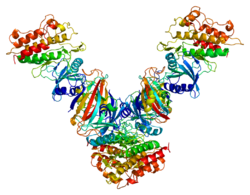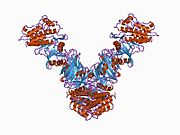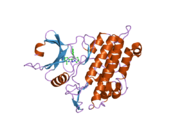TGFβ수용체1
TGF beta receptor 1형질전환성장인자 베타수용체 I(액티빈 A수용체 타입 II 유사인산화효소, 53kDa)는 시그널링 리간드의 TGF 베타수용체 패밀리의 막결합 TGF 베타수용체 단백질이다.TGFBR1은 인간의 유전자이다.
기능.
이 유전자에 의해 암호화된 단백질은 TGF-β에 결합되었을 때 Type II TGF-β 수용체와 이질체 복합체를 형성하여 TGF-β 신호를 세포 표면에서 세포질로 변환한다.코드화된 단백질은 세린/트레오닌 단백질 키나제이다.이 유전자의 돌연변이는 Loies-Dietz 대동맥류 증후군(LDS, LDAS)[5]과 관련이 있다.
상호 작용
TGF 베타 수용체 1은 다음과 상호작용하는 것으로 나타났습니다.
억제제
- GW-788,388
- LY-2109761
- Galunisertib (LY-2157299)
- SB-431,542
- SB-525,334
- 리스옥스[24]
동물 연구
TGFBR-1 유전자가 녹아웃되거나 구성적으로 활성화된 TGFBR-1 돌연변이(배위자의 유무에 관계없이 활성)가 녹인 경우 결함이 관찰된다.
마우스 TGFBR-1 녹아웃 모델에서 암컷 마우스는 멸균 상태였습니다.그들은 자궁 평활근 층이 제대로 형성되지 않았다는 것을 의미하는 배란 게실과 결함이 있는 자궁 평활근을 발달시켰다.난관 게실은 난소에서 자궁으로 난자를 운반하는 튜브인 난관에 위치한 작고 불룩한 주머니입니다.난관의 이러한 기형은 양쪽으로 발생했고 배아 발달 장애와 자궁으로의 배아의 전달 장애를 초래했다.녹아웃에서 배란과 수정이 여전히 이루어졌지만, 이 배란 [25]게실에서는 배아의 잔여물이 발견되었다.
구성 활성 TGFBR-1 유전자가 조건부로 유도되는 마우스 TGFBR-1 노크인 모델에서 TGFBR-1 수용체의 과잉 활성화는 불임, 자궁선수 감소 및 자궁근육(자궁내 [26]평활근의 증가량)을 초래한다.
이러한 실험은 TGFB-1 수용체가 여성 생식관의 기능에 중요한 역할을 한다는 것을 보여준다.그들은 또한 TGFBR-1 유전자의 유전자 돌연변이가 여성의 불임 문제를 야기할 수 있다는 것을 보여준다.
레퍼런스
- ^ a b c GRCh38: 앙상블 릴리즈 89: ENSG00000106799 - 앙상블, 2017년 5월
- ^ a b c GRCm38: 앙상블 릴리즈 89: ENSMUSG00000007613 - 앙상블, 2017년 5월
- ^ "Human PubMed Reference:". National Center for Biotechnology Information, U.S. National Library of Medicine.
- ^ "Mouse PubMed Reference:". National Center for Biotechnology Information, U.S. National Library of Medicine.
- ^ "Entrez Gene: TGFBR1 transforming growth factor, beta receptor I (activin A receptor type II-like kinase, 53kDa)".
- ^ a b Razani B, Zhang XL, Bitzer M, von Gersdorff G, Böttinger EP, Lisanti MP (March 2001). "Caveolin-1 regulates transforming growth factor (TGF)-beta/SMAD signaling through an interaction with the TGF-beta type I receptor". The Journal of Biological Chemistry. 276 (9): 6727–38. doi:10.1074/jbc.M008340200. PMID 11102446.
- ^ Guerrero-Esteo M, Sanchez-Elsner T, Letamendia A, Bernabeu C (August 2002). "Extracellular and cytoplasmic domains of endoglin interact with the transforming growth factor-beta receptors I and II". The Journal of Biological Chemistry. 277 (32): 29197–209. doi:10.1074/jbc.M111991200. PMID 12015308.
- ^ Barbara NP, Wrana JL, Letarte M (January 1999). "Endoglin is an accessory protein that interacts with the signaling receptor complex of multiple members of the transforming growth factor-beta superfamily". The Journal of Biological Chemistry. 274 (2): 584–94. doi:10.1074/jbc.274.2.584. PMID 9872992.
- ^ Wang T, Donahoe PK, Zervos AS (July 1994). "Specific interaction of type I receptors of the TGF-beta family with the immunophilin FKBP-12". Science. 265 (5172): 674–6. Bibcode:1994Sci...265..674W. doi:10.1126/science.7518616. PMID 7518616.
- ^ Liu F, Ventura F, Doody J, Massagué J (July 1995). "Human type II receptor for bone morphogenic proteins (BMPs): extension of the two-kinase receptor model to the BMPs". Molecular and Cellular Biology. 15 (7): 3479–86. doi:10.1128/mcb.15.7.3479. PMC 230584. PMID 7791754.
- ^ Kawabata M, Imamura T, Miyazono K, Engel ME, Moses HL (December 1995). "Interaction of the transforming growth factor-beta type I receptor with farnesyl-protein transferase-alpha". The Journal of Biological Chemistry. 270 (50): 29628–31. doi:10.1074/jbc.270.50.29628. PMID 8530343.
- ^ Wrighton KH, Lin X, Feng XH (July 2008). "Critical regulation of TGFbeta signaling by Hsp90". Proceedings of the National Academy of Sciences of the United States of America. 105 (27): 9244–9. Bibcode:2008PNAS..105.9244W. doi:10.1073/pnas.0800163105. PMC 2453700. PMID 18591668.
- ^ Mochizuki T, Miyazaki H, Hara T, Furuya T, Imamura T, Watabe T, Miyazono K (July 2004). "Roles for the MH2 domain of Smad7 in the specific inhibition of transforming growth factor-beta superfamily signaling". The Journal of Biological Chemistry. 279 (30): 31568–74. doi:10.1074/jbc.M313977200. PMID 15148321.
- ^ Asano Y, Ihn H, Yamane K, Kubo M, Tamaki K (January 2004). "Impaired Smad7-Smurf-mediated negative regulation of TGF-beta signaling in scleroderma fibroblasts". The Journal of Clinical Investigation. 113 (2): 253–64. doi:10.1172/JCI16269. PMC 310747. PMID 14722617.
- ^ Koinuma D, Shinozaki M, Komuro A, Goto K, Saitoh M, Hanyu A, Ebina M, Nukiwa T, Miyazawa K, Imamura T, Miyazono K (December 2003). "Arkadia amplifies TGF-beta superfamily signalling through degradation of Smad7". The EMBO Journal. 22 (24): 6458–70. doi:10.1093/emboj/cdg632. PMC 291827. PMID 14657019.
- ^ Kavsak P, Rasmussen RK, Causing CG, Bonni S, Zhu H, Thomsen GH, Wrana JL (December 2000). "Smad7 binds to Smurf2 to form an E3 ubiquitin ligase that targets the TGF beta receptor for degradation". Molecular Cell. 6 (6): 1365–75. doi:10.1016/s1097-2765(00)00134-9. PMID 11163210.
- ^ Hayashi H, Abdollah S, Qiu Y, Cai J, Xu YY, Grinnell BW, Richardson MA, Topper JN, Gimbrone MA, Wrana JL, Falb D (June 1997). "The MAD-related protein Smad7 associates with the TGFbeta receptor and functions as an antagonist of TGFbeta signaling". Cell. 89 (7): 1165–73. doi:10.1016/s0092-8674(00)80303-7. PMID 9215638. S2CID 16552782.
- ^ a b Datta PK, Moses HL (May 2000). "STRAP and Smad7 synergize in the inhibition of transforming growth factor beta signaling". Molecular and Cellular Biology. 20 (9): 3157–67. doi:10.1128/mcb.20.9.3157-3167.2000. PMC 85610. PMID 10757800.
- ^ Griswold-Prenner I, Kamibayashi C, Maruoka EM, Mumby MC, Derynck R (November 1998). "Physical and functional interactions between type I transforming growth factor beta receptors and Balpha, a WD-40 repeat subunit of phosphatase 2A". Molecular and Cellular Biology. 18 (11): 6595–604. doi:10.1128/mcb.18.11.6595. PMC 109244. PMID 9774674.
- ^ Datta PK, Chytil A, Gorska AE, Moses HL (December 1998). "Identification of STRAP, a novel WD domain protein in transforming growth factor-beta signaling". The Journal of Biological Chemistry. 273 (52): 34671–4. doi:10.1074/jbc.273.52.34671. PMID 9856985.
- ^ Ebner R, Chen RH, Lawler S, Zioncheck T, Derynck R (November 1993). "Determination of type I receptor specificity by the type II receptors for TGF-beta or activin". Science. 262 (5135): 900–2. Bibcode:1993Sci...262..900E. doi:10.1126/science.8235612. PMID 8235612.
- ^ Oh SP, Seki T, Goss KA, Imamura T, Yi Y, Donahoe PK, Li L, Miyazono K, ten Dijke P, Kim S, Li E (March 2000). "Activin receptor-like kinase 1 modulates transforming growth factor-beta 1 signaling in the regulation of angiogenesis". Proceedings of the National Academy of Sciences of the United States of America. 97 (6): 2626–31. Bibcode:2000PNAS...97.2626O. doi:10.1073/pnas.97.6.2626. PMC 15979. PMID 10716993.
- ^ Kawabata M, Chytil A, Moses HL (March 1995). "Cloning of a novel type II serine/threonine kinase receptor through interaction with the type I transforming growth factor-beta receptor". The Journal of Biological Chemistry. 270 (10): 5625–30. doi:10.1074/jbc.270.10.5625. PMID 7890683.
- ^ Mishra, Tarun; Bhardwaj, Vipin; Ahuja, Neha; Gadgil, Pallavi; Ramdas, Pavitra; Shukla, Sanjeev; Chande, Ajit (June 2022). "Improved loss-of-function CRISPR-Cas9 genome editing in human cells concomitant with inhibition of TGF-β signaling". Molecular Therapy - Nucleic Acids. 28: 202–218. doi:10.1016/j.omtn.2022.03.003. PMC 8961078. PMID 35402072. S2CID 247355285.
- ^ Li Q, Agno JE, Edson MA, Nagaraja AK, Nagashima T, Matzuk MM (October 2011). "Transforming growth factor β receptor type 1 is essential for female reproductive tract integrity and function". PLOS Genetics. 7 (10): e1002320. doi:10.1371/journal.pgen.1002320. PMC 3197682. PMID 22028666.
- ^ Gao Y, Duran S, Lydon JP, DeMayo FJ, Burghardt RC, Bayless KJ, Bartholin L, Li Q (February 2015). "Constitutive activation of transforming growth factor Beta receptor 1 in the mouse uterus impairs uterine morphology and function". Biology of Reproduction. 92 (2): 34. doi:10.1095/biolreprod.114.125146. PMC 4435420. PMID 25505200.
추가 정보
- Massagué J (June 1992). "Receptors for the TGF-beta family". Cell. 69 (7): 1067–70. doi:10.1016/0092-8674(92)90627-O. PMID 1319842. S2CID 54268875.
- Wrana JL (1998). "TGF-beta receptors and signalling mechanisms". Mineral and Electrolyte Metabolism. 24 (2–3): 120–30. doi:10.1159/000057359. PMID 9525694. S2CID 84458561.
- Josso N, di Clemente N, Gouédard L (June 2001). "Anti-Müllerian hormone and its receptors". Molecular and Cellular Endocrinology. 179 (1–2): 25–32. doi:10.1016/S0303-7207(01)00467-1. PMID 11420127. S2CID 27316217.












